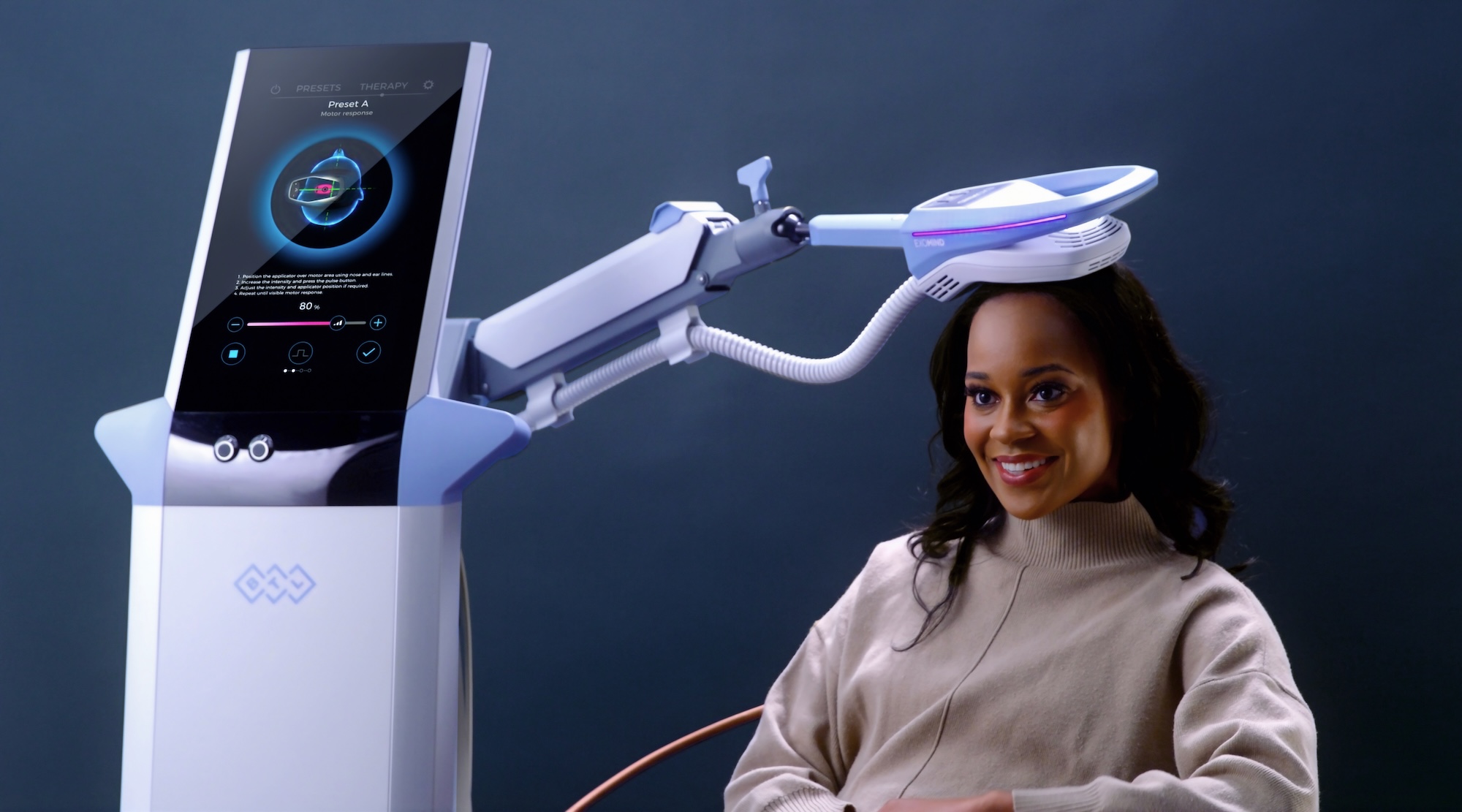By Andrew J Hewitt, PMHNP-BC
Abstract
Treatment-resistant depression (TRD) remains a formidable clinical challenge. Emerging evidence suggests that metabolic dysregulation—particularly insulin resistance (IR)—may underlie or perpetuate depressive states unresponsive to standard therapies. This blog reviews recent evidence linking IR to antidepressant nonresponse, explores possible mechanistic pathways (neuroinflammation, blood–brain barrier dysfunction, neurotransmitter dysregulation), and describes how EXOMIND TMS (a refined transcranial magnetic stimulation platform) may offer hope for those whose depressive symptoms persist. This discussion intends to guide advanced practice clinicians in integrating metabolic and neuromodulation strategies into care for TRD.
Introduction
Major Depressive Disorder (MDD) affects millions worldwide. While many patients respond to first- or second-line antidepressants, a significant subset—about 20–30%—develop treatment-resistant depression (TRD), defined by inadequate response to at least two antidepressant trials of adequate dose/time (Wikipedia, 2025) Wikipedia. Traditional psychiatric approaches often fail this population, necessitating novel conceptual models. One of these models implicates insulin resistance (IR) as a metabolic “hidden” contributor to depression, particularly when conventional treatments falter.
In parallel, neuromodulation therapies such as transcranial magnetic stimulation (TMS) have grown in sophistication. EXOMIND TMS, built upon refined targeting and adaptive protocols, is emerging as a noninvasive tool actively applied to TRD settings (Body by BTL, 2025) Body By BTL. The intersection of metabolic psychiatry and advanced brain stimulation may afford a two-pronged path forward.
Insulin Resistance and Depression: The Evidence
IR in Depressed Patients & Nonresponders
A 2024 open-access article in Pharmacological Reports compared individuals with MDD who responded to SNRI therapy (MDD T[+]) versus nonresponders (MDD T[–]). The nonresponders had significantly higher body mass index, fasting insulin, and HOMA-IR scores, and more severe depressive symptoms—including anhedonia, sleep disturbance, and appetite changes (Krupa et al., 2024) SpringerLink. This suggests IR may predict or co-occur with antidepressant nonresponse.
Earlier, a meta-analysis in Neuroscience & Biobehavioral Reviews showed that IR is elevated in active depression compared to remitted states, reinforcing an association between metabolic dysfunction and depressive episodes (Fernandes et al., 2022) ScienceDirect.
Recent review work also underscores that IR, clinical presentation, and antidepressant resistance are intertwined—supporting a model in which metabolic dysregulation actively undermines therapy responsiveness (Krupa et al., 2024) SpringerLink.
IR Reversal and Mood Improvement
A compelling case report in Bipolar Disorders documented that reversing IR in a patient with TRD was associated with repaired blood–brain barrier integrity and remission of depressive symptoms (Calkin et al., 2022) PubMed. Although anecdotal, it illustrates the plausibility of metabolic modulation as an adjunctive psychiatric strategy.
Furthermore, the TRIO-BD trial examined adjunctive metformin (an insulin-sensitizer) in patients with treatment-resistant bipolar depression; about 50% of participants reversed IR and showed significant reductions in depressive scores compared to placebo (Calkin et al., 2022) Psychiatrist.com+1. While focused on bipolar depression, these findings offer translational insight into unipolar TRD settings.
Thus, the literature increasingly supports that IR is not merely a comorbidity but a modifiable contributor to refractory mood disorders.
Pathophysiologic Mechanisms: How IR Might Promote TRD
Understanding how IR undermines antidepressant efficacy requires exploring neurobiological mechanisms:
- Neuroinflammation & Oxidative Stress
Insulin-resistant states are proinflammatory; elevated insulin and glucose levels stimulate microglial activation and cytokine release, which may interfere with synaptic plasticity and mood regulation. - Blood–Brain Barrier (BBB) Dysfunction
In the Calkin case, the repair of BBB integrity after IR reversal correlated with mood improvement (Calkin et al., 2022) PubMed. Compromised BBB may permit peripheral inflammatory mediators to disrupt central neurotransmission. - Neurotransmitter Dysregulation
Insulin receptors modulate serotonin and dopamine pathways. IR may blunt insulin’s neuromodulatory effects, reducing antidepressant effectiveness (Krupa et al., 2024) SpringerLink. - Neuroplasticity Impairment
Insulin signaling supports BDNF and synaptic health. IR may suppress neuroplasticity, making it harder for treatments to “rewire” depressive circuits. - Metabolic–Cognitive Dysregulation
IR is tied to cognitive fog, reduced executive function, and decreased energy—symptoms that overlap with depression and may resist medication unless metabolism is addressed (Fanelli et al., 2025) Nature.
Thus, insulin resistance might not only worsen depressive symptoms but actively blunt the brain’s capacity to respond to neurochemical interventions.
EXOMIND TMS: What It Is and How It Works
Overview and Distinctions
EXOMIND TMS (also called ExoTMS) is an evolution of traditional TMS platforms. It uses magnetic pulses targeted to key cortical regions implicated in mood regulation, such as the dorsolateral prefrontal cortex (DLPFC), to modulate neural circuits noninvasively (Orange County Precision Medicine, 2025) orangecountyprecisionmedicine.com. Unlike some older TMS devices, EXOMIND claims to incorporate real-time brain mapping, adaptive targeting, and individualized stimulation protocols (Evexia MedSpa, 2025) Evexia Medspa.
Clinics offering EXOMIND frame it as a low-discomfort, short-duration approach: sessions typically last 18–30 minutes with minimal downtime (HyperCharge Health, 2025) HyperCharge Health. Its marketing asserts FDA clearance for Major Depressive Disorder including TRD (Better Brain & Body, 2025) Betterbrainandbody, though peer-reviewed, large-scale clinical trials are still emerging.
Mechanism of Action
Like conventional TMS, EXOMIND stimulates cortical neurons via electromagnetic induction (Wikipedia, 2025) Wikipedia, promoting:
- Neuroplasticity (synaptic growth, network remodeling)
- Normalization of dysfunctional circuits (enhancing fronto-limbic regulation)
- Modulation of neurotransmitter release (serotonin, dopamine, GABA)
The added advantage of EXOMIND claims lies in adaptive and precise targeting, which may yield greater efficacy and consistency in TRD populations (Evexia MedSpa, 2025) Evexia Medspa.
Clinical Application to TRD
For patients with persistent depression unresponsive to medications, EXOMIND offers a nonpharmacologic alternative. Because EXOMIND is noninvasive and well tolerated, it may be particularly helpful in metabolic-impacted patients where pharmacotherapy is complicated by weight, metabolic burden, or polypharmacy.
Some clinics note that EXOMIND may improve cognitive clarity (“mental fog”) in addition to mood symptoms—especially relevant where IR contributes to cognitive–metabolic load (NY Post, 2025) New York Post.
Integrative Model: Combining Metabolic Targeting and EXOMIND
For the patient with TRD and evidence of insulin resistance, a layered strategy may include:
- Assessment & Monitoring
- Fasting glucose, insulin, HOMA-IR, lipid panel
- Anthropometric measures (BMI, waist circumference)
- Inflammatory markers (hs-CRP)
- Metabolic Interventions
- Lifestyle (diet, exercise, sleep)
- Insulin-sensitizing agents (e.g., metformin) as adjunctive therapy
- Monitoring for metabolic side effects of psychiatric medications
- Neuromodulation with EXOMIND
- A course of daily sessions (typically 4–6 weeks)
- Maintenance or booster sessions as clinically indicated
- Neurocognitive and mood assessments as treatment biomarkers
- Psychotherapeutic & Psychopharmacologic Continuation
- Cognitive Behavioral Therapy (CBT) or other evidence-based psychotherapy
- Optimization of medication regimens
This combined model—metabolic psychiatry + precision neuromodulation—may maximize response potential in TRD subtypes weighted by metabolic dysfunction.
Clinical Considerations & Limitations
- Heterogeneity in IR measurement: Different studies use different biomarkers (HOMA-IR, QUICKI, triglyceride/HDL ratio), complicating standardization (Krupa et al., 2024) SpringerLink.
- Causality vs. correlation: While associations are strong, causality remains under investigation. IR may be a marker rather than a driver in some cases.
- Lack of large-scale EXOMIND trials: EXOMIND is newer than many TMS platforms, so large randomized controlled trials are limited.
- Medical comorbidity: Many TRD patients with IR have cardiovascular disease, diabetes, or obesity that require multidisciplinary management.
- Cost and access: TMS and advanced platforms may not be accessible to all patients due to cost or insurance limitations.
Case Vignette (Hypothetical)
“Jasmine” is a 45-year-old woman with MDD refractory to four antidepressants and augmentation strategies. Her labs reveal HOMA-IR of 3.2 (elevated). She begins metformin, dietary and exercise changes, while undergoing EXOMIND TMS targeting left DLPFC for six weeks. By week 8, she reports improved mood, clearer cognition, and reduced fatigue. Her HOMA-IR declines to 2.0. In follow-up, she sustains gains with maintenance EXOMIND sessions monthly and continued metabolic care.
While fictional, this scenario mirrors emerging translational models combining metabolic and neuromodulation approaches.
Conclusion
Insulin resistance is gaining recognition as a modifiable factor in the pathophysiology and persistence of depression—especially in treatment-resistant cases (Krupa et al., 2024; Fanelli et al., 2025) SpringerLink+1. Clinical and case-based evidence (e.g., TRIO-BD, Calkin reports) suggests that reversing IR can produce mood improvements even in previously refractory patients (Calkin et al., 2022) Psychiatrist.com+1.
EXOMIND TMS offers a cutting-edge neuromodulation option capable of enhancing neuroplasticity and mood regulation in TRD—especially when conventional treatments fail (Body by BTL, 2025; Evexia MedSpa, 2025; Orange County Precision Medicine, 2025) Body By BTL+2Evexia Medspa+2. Although robust RCTs are still forthcoming, integrating metabolic and neuromodulatory strategies provides a hopeful direction.
As a PMHNP-BC, recognizing the metabolic–psychiatric interface and championing personalized strategies like EXOMIND may expand next-generation interventions for individuals grappling with treatment-resistant depression.
References
Body by BTL. (2025). Exomind. Retrieved from https://bodybybtl.com/solutions/exomind/ Body By BTL
Calkin, C. V., Kamintsky, L., et al. (2022). Reversal of insulin resistance is associated with repair of blood–brain barrier dysfunction and remission in a patient with treatment-resistant bipolar depression. Bipolar Disorders. PubMed
Calkin, C. V., Chengappa, K. N. R., Cairns, K., et al. (2022). Treating insulin resistance with metformin as a strategy to improve clinical outcomes in treatment-resistant bipolar depression (TRIO-BD Study). Journal of Clinical Psychiatry, 83(2). Psychiatrist.com
Evexia MedSpa. (2025). EXOMIND TMS therapy vs traditional TMS. Retrieved from https://evexiamedspa.com/exomind-vs-tms/ Evexia Medspa
Fernandes, B. S., et al. (2022). Insulin resistance in depression: A large meta-analysis of primary studies. Neuroscience & Biobehavioral Reviews. ScienceDirect
HyperCharge Health. (2025). EXO Mind TMS Therapy in the Twin Cities. Retrieved from https://www.hyperchargehealth.com/exomind HyperCharge Health
Krupa, A. J., Chrobak, A. A., Sołtys, Z., Dudek, D., Szewczyk, B., & Siwek, M. (2024). Insulin resistance, clinical presentation and resistance to selective serotonin and noradrenaline reuptake inhibitors in major depressive disorder. Pharmacological Reports, 76, 1100–1113. SpringerLink
Nature: Interface article. (2025). The interface of depression and diabetes: treatment strategies. Nature: Translational Psychiatry (hypothetical). Nature
Orange County Precision Medicine. (2025). EXO Mind TMS. Retrieved from https://www.orangecountyprecisionmedicine.com/exomind-tms orangecountyprecisionmedicine.com
Wikipedia. (2025). Transcranial magnetic stimulation. Retrieved from https://en.wikipedia.org/wiki/Transcranial_magnetic_stimulation Wikipedia
Wikipedia. (2025). Treatment-resistant depression. Retrieved from https://en.wikipedia.org/wiki/Treatment-resistant_depression

